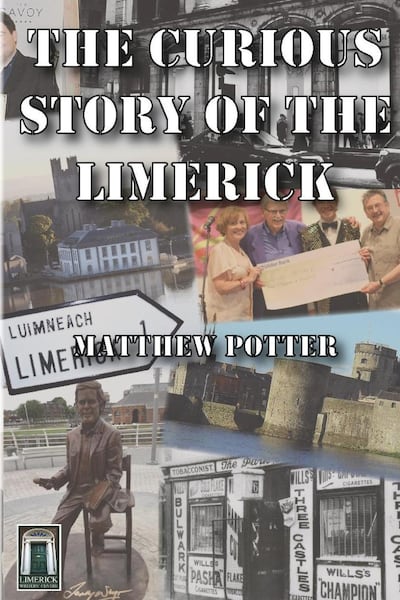"Who, thinking of limericks, could approach Limerick without picturing a cheerful town"
Heinrich Böll, who visited Limerick in 1972
Limerick is the only place in Ireland to give its name to a form of poetry or indeed any other literary form. And not just any literary form! The limerick is the most popular poem in the world’s most important language, English. One third of the world’s population, amounting to two billion people, speak English as either their first or second language. Many of these have read limericks, laughed at limericks, or even tried to write their own limericks. As a result, the city and county of Limerick have a link to a global poetic community made up of millions of people from Canada to Australia and from Scotland to India.
Dominic Taylor of Limerick Writers Centre, publisher of my book, The Curious Story of the Limerick, says: "One of the principal aims of this book is to create an awareness of the connection between the place and the poem so that limerick can establish itself internationally as one of the few places that gave its name to a literary form. Think Shakespeare and Stratford, Joyce and Dublin, Burns and Scotland, Limerick and the limerick."
The Curious Story of the Limerick tells a fascinating tale, populated with a gallery of major and not so major literary figures, and one learns with amazement that the limerick form featured in the works of Shakespeare, Lewis Carroll and even James Joyce. It also refers to lesser literary figures, both weird (Edward Lear, the so-called father of the limerick) and weirdly named (such as American limericks expert Gershon Legman) who specialised in this literary form. Even more interesting is the number of major figures from other spheres who were also composers of limericks: politics (Clement Attlee), music (Gilbert and Sullivan) and entertainment (Spike Milligan).
The book also gets to grips with the vexed question of how, why and when the limerick got its name and examines a number of different theories. These include the difficulty of rhyming the word “limerick” with any other word; a late 19th-century parlour game in which the competitors composed extemporised verses, which was followed by a chorus containing the words “Will you come up to Limerick?”; the role of the Irish Brigade in 18th-century France; and the Irish word “leamairic” or “leabharaic”, meaning “trickster”, “rogue” or “rhymer”.
My own favourite theory is that the poetic form takes its name from the 18th-century Maigue Poets, Seán Ó Tuama and Aindrias MacCraith, from Croom in Co Limerick who used it extensively in their works. They did not invent the limerick but probably gave their name to it, though in a roundabout way. The name arose in the late 1880s and early 1890s as a result of the efforts by W B Yeats and George Sigerson, leading figures in the Irish Literary Revival, to reclaim the limerick form from Edward Lear and to ascribe it instead to the Maigue Poets. This attracted the derision of the British literary establishment who began to use the term limerick for obscene versions.

In turn, the Irish literary community was outraged, both because of the ridicule thus cast on their homeland and their prudish disapproval of obscene limericks. One of the most severe critics of this misuse of the name limerick was Fr Matthew Russell, a Jesuit priest who edited The Irish Monthly journal from 1873 until his death. A major figure in Irish literary circles, Fr Russell coined the term "learic" (after Lear) for clean limericks, but it never caught on. Accordingly, the term "limerick" caught on and is still with us.
I have not reached a definite conclusion but says that “‘our research into the origins of the name continues and we are confident that we will eventually find the answer”.
The Curious Story of the Limerick was launched as part of the annual Bring Your Limericks to Limerick international poetry competition organised by the Limerick Writers' Centre which has become a fixture in the Irish literary calendar. The book can be purchased online at limerickwriterscentre.com, O'Mahony Booksellers, Limerick and Kennys in Galway.
The Limerick Writers' Centre was founded as a non-profit organisation in 2008 to support and promote writers from or living in Limerick through readings, workshops and publishing activities.
The Curious Story of the Limerick by Matthew Potter is launched by. Stephen Keary, Mayor of Limerick, on Friday, August 25th, at5pm, in Dolans, The Gin Room, Dock Rd, Limerick
A selection of limericks
Lewis Carroll (1832-98)
There was an eccentric old draper
Who wore a hat made of brown paper;
It went up to a point,
Yet it looked out of joint,
The cause of which he said was 'vapour'.
Clement Attlee (1883-1967)
Few thought he was even a starter.
There were many who thought themselves smarter.
But he finished PM,
A CH, an OM,
An earl and a Knight of the Garter.
James Joyce (1882-1941)
There once was a lounger named Stephen
Whose youth was most odd and uneven
He throve on the smell
Of a horrible hell
That a Hottentot wouldn't believe in.
Ogden Nash (1902-71)
There was a young lady called Harris
That nothing could ever embarrass
Till the bath salts, one day
In the tub where she lay
Turned out to be Plaster of Paris.
WH Auden (1907-73)
TS Eliot is quite at a loss
When clubwomen bustle across
At literary teas
Crying, "What, if you please,
Did you mean by The Mill on the Floss?"
Spike Milligan (1918-2002)
Daddy how does an elephant feel
When he swallows a piece of steel?
Does he get drunk
And fall on his trunk
Or roll down the road like a wheel?
Dominic Taylor, Limerick Writers' Centre
If Shakespeare and Stratford succeed
Their link forever guaranteed
Then should we be embarking
Quite soon on trademarking
The Limerick with our title deed?

















